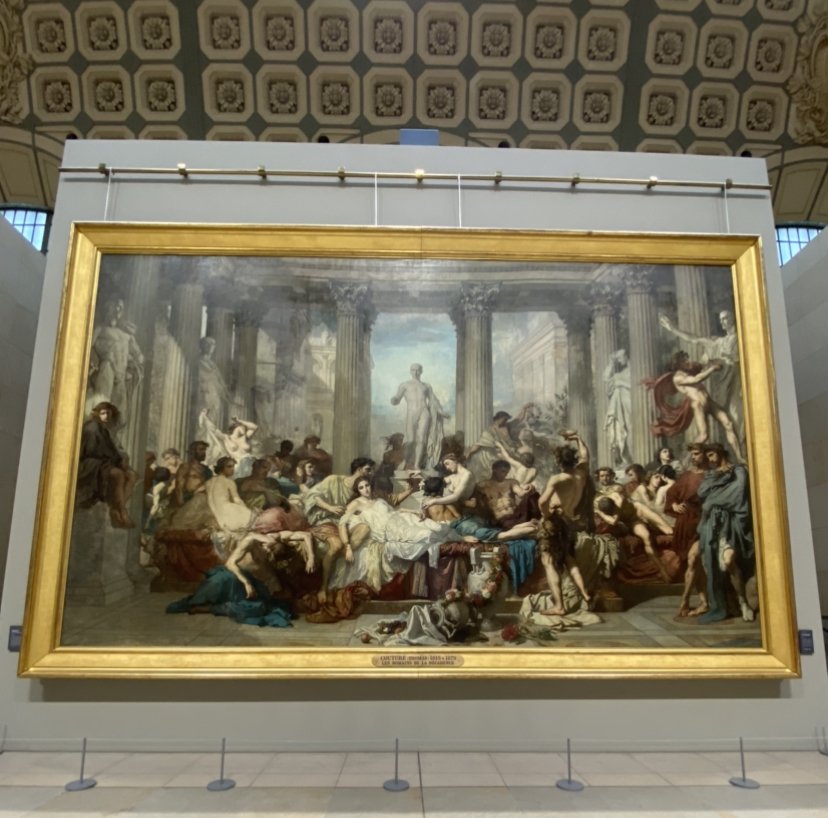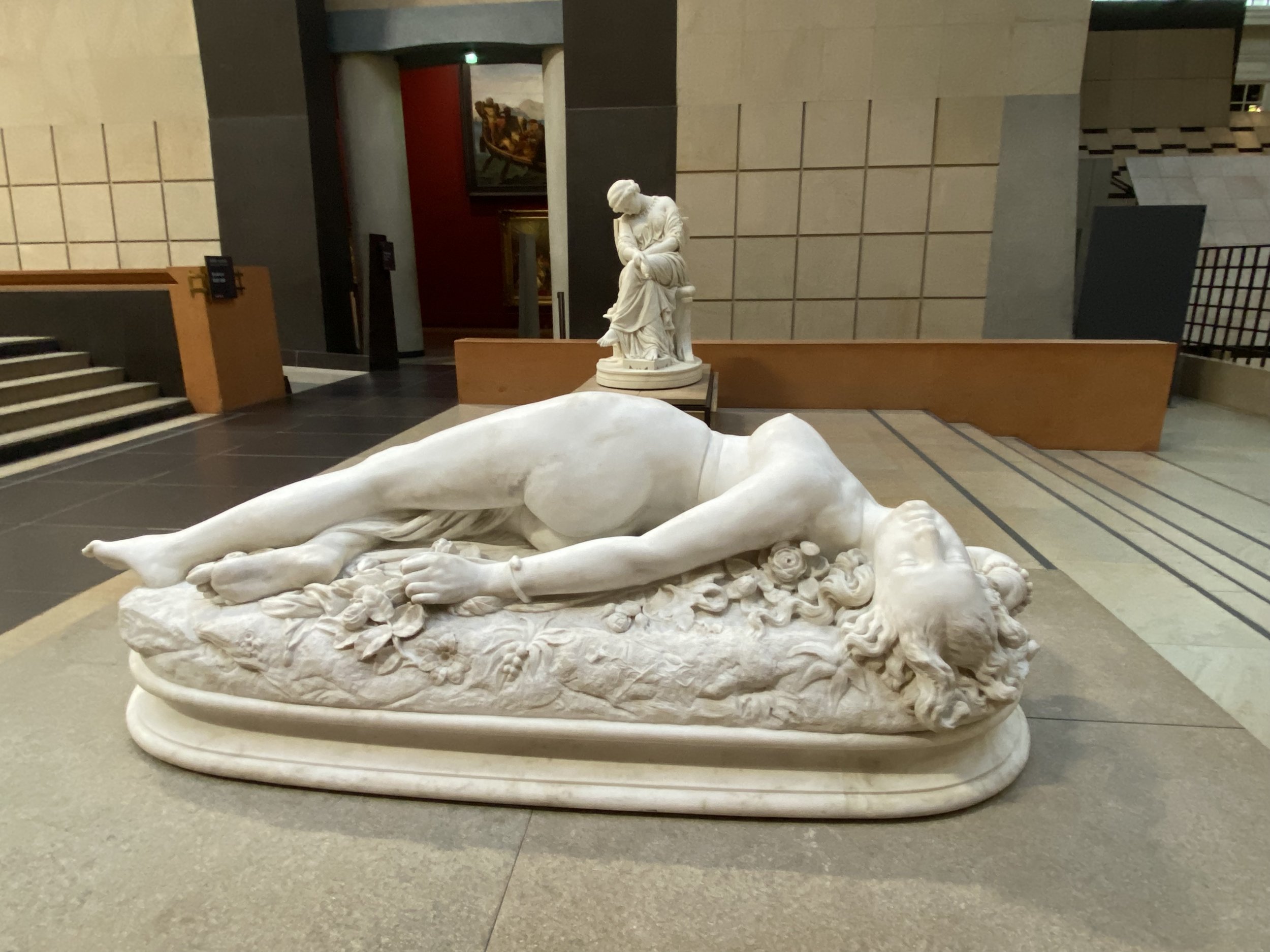The Musée d’Orsay is the beacon of Impressionist light sitting on the edge of the Rive Gauche. Of course it is known for those amazing paintings of Monet and Renoir but it also holds a fw other treasures and some of the most lovely sculptures in Paris. On this month of LOVE we will take a look at a few others that have their own little take on love.
The relationship between Camille Claudel and Rodin was one of inspiration, love and eventually anger. As his muse and lover, Camille wanted to marry the famous artist but he was still with his longtime partner Rose. In 1892 she ended the relationship but her feelings for Rodin were still there. In 1895 the French government commissioned Camille to create a sculpture for the State. Her striking, beautiful and heart breaking sculpture L’Age Mur was her answer.
It depicts an older woman leading an older man away while his arm reaches back to a young woman on her knees pleading with him to stay. Believing that the older woman was Rose leading Rodin away as Camille reaches out while on her knees. Many including Roden thought this was a message to their relationship and were outraged. The French government canceled the commission when they saw the subject and how it offended Rodin. Camille would still complete it and it would be exhibited in 1899, much to the chagrin of Rodin. Up until this point Rodin supported her financially but that ended with L’Age Mur and her final break from the sculptor. He would later do all he could to help save her from the fate her brother put her in, but sadly it wouldn’t work.
For more on Camille, listen to our podcast episode about her tragic life
Painted in 1865 by Gustave Moreau, Orphée tells the story of Orphée or Oprheus from the poem Metamorphoses by Ovid written in 8 AD, complete with more than 250 stories of Greek mythology. Orpheus was the son of Apollo and the Muse Calliope and was a talented musician and poet who could charm anybody including the wildest of beasts. But it was a follower of Dionysus, the Maenads who ripped his body to shreds after the death of his wife, Eurydice. In the painting by Moreau his head is seen laying on his lyre being held in the arms of a young girl who looks at him lovingly. Set against the landscape reminiscent of a da Vinci painting, it is beautiful and serene in the face of such a barbaric act. Exhibited at the Salon of 1866 it was purchased by the state for the Musée du Luxembourg, where the art of living artists was displayed until it eventually moved to the Louvre and finally landed at the Orsay.
Now look closer at the face of Orpheus. Does it look familiar at all? The face Moreau used is that of the Dying Slave by Michelangelo. The two unfinished statues that were created for the tomb of Pope Julius II but never came to fruition. Instead he gave 2 of the 6 statues to Roberto Strozzy who would then give them to King Francois I of France and would eventually end up in their final home, the Musée du Louvre. The Dying Slave appears to be young and handsome and thought to be asleep. He looks rather sensual and at peace, more so then his friend the Rebellious Slave next to him.
Claude Monet was enamored with Camille Doncleux, he would use her for the model of every woman in Les Femmes au jardin et Le Dejeuner. Look closely at each of the women, they are all Camille. She would also sit for Renoir and Manet, Manet even painted the couple and family a few times. In 1870 the two would finally marry and in 1878 they would have their second son Michel. Camille would develop cancer shortly after and a year later she would be gone.
As Monet watched his beloved wife Camille slip away he said “I caught myself watching her tragic temples almost mechanically searching for the sequence of changing shades which death was imposing upon her rigid face. Blue, yellow, grey. My reflexes compelled me to the unconscious action in spite of myself”, he picked up a canvas and painted her. Everything about this painting, even as heartbreaking as it is, is beautiful and shows how the painter tried to hold onto her until the very last possible second.
The sculpture Oedipe á Colone by Jean Baptiste Hughes found on the upper terrace tells the story of love between a child and parent. Created in 1885, Hughes pulled the theme from Homer and created it out of marble. “Here we are under the olive trees of Colones in the first scene. Set me on a rock, said Oedipe and look after your blind father”. Beautifully sculpted, the older Oedipe shows his age while his daughter Antigone sits next to him with her head on his shoulder looking up adoringly at him. It’s amazing how much emotion can come through in a chunk of stone.
Thomas Couture’s Les Romains de la Décadence was shown at the Salon of 1847 and left a very memorable impression. The history painter wanted to remind the quickly changing Paris heading into the Industrial Revolution that French painting was rooted in Greek and Renaissance style. Following the Romantic movement of color, emotion and movement Couture wanted to bring back the academic style.
The center of the painting is pure debauchery with half naked drunk men and women. The lower left has a sad gentleman at the base of a statue looking down and on the right two fully clothed men look on in judgment. They all are framed by the very classic columns and marble statues reminding you of the past. What Couture was also doing was making a statement on the current climate in France. The excess and moral decay of the July Monarchy and to tell us not to forget our values deeply set in culture.
When it appeared at the Salon critics thought it was a blend of Classicalism as well as Romanticism which didn’t please Couture. The female bodies were inspired by the paintings of Ingres which you will see more of next week.
Couture might be remembered more for his students including Manet and Pierre Puvis de Chavannes as well as Berthe Morisot.
No one captured motherhood like Berthe Morisot and in 1872 she painted what could be her most popular painting, Le Berceau, The Cradle. The subject is her sister Edme who also started out as a painter and her new daughter Blanche who is sleeping in the cradle. She lovingly looks down on her and we see her little face through the sheer fabric hanging over her cradle.
It was Berthe’s first painting of motherhood and when she gave birth to her own daughter in 1878 she would become her favorite model. The Cradle stayed with the family and to Blancehe Pontillau who was the baby until 1930 when it was given to the Louvre and eventually to the Orsay.
Learn more about Berthe Morisot’s life and the legacy she left behind in an early episode of the podcast.
Pierre Bonnard was a founding member of Les Nabis inspired by Gauguin and the Japanese woodcut prints. His painting Man and Woman around 1900 is of his wife Marthe and himself. He stands nude in the foreground and she sits back on the bed. The two seem very separate and apart and could be because of their real life story.
Marthe Boursin Bonnard was born in 1869 and moved to Paris to work in a flower making shop. Shortly after she met Pierre and told him her name was Marthe de Méligny and of Italian royalty. She told him the truth after they were married but their entire marriage was filled with jealousy, anxiety and bouts of madness that sometimes separated them. She was his model for the first years of their life together then disappeared from the canvases all together.
A stunning sculpture of marble created by Auguste Clésinger appeared at the Salon of 1847 at the same time as Coutures Roman Decadence, which is widely known as the Roman Orgy. Clésinger was commissioned by rich industrialist Alfred Mosselman to create a sculpture of his mistress Apollonie Sabatier. She was known as La Presidente for her popular salons and also as the muse of artists and poets. Baudelaire was so inspired by her he wrote a few poems in Les Fleur des Mal about her.
She lays with her back arched in what appears to be ecstasy. The title of the piece is Woman Stung by a Snake and if you look closely you can find the small snake wrapped around her wrist. Theophile Gautier said of the piece “Pure orgasmix delirium, the disheveled Maeriad tumbles at the feet of Bacchus, father of liberty and joy. A powerful spasm of happiness”
However that is not what freaked people out. It appeared to be created from her actual body. In the 19th century there was a controversial technique known as body sculpting that was natural molding of the body. Look closely at the back of her upper thighs, the dimples of cellulite set off an alarm with everyone that saw her.
To plead his case he recreated a slightly larger version now in the Petit Palais. Rodin was also accused of this in 1840 for his Age of Bronze lifesize figure of a man.
Renoir was commissioned in 1883 to create three paintings with the theme of dance by Paul Durand-Ruel. He used his favorite model Suzanne Valadon who he had worked with for five years. The young model soaked up everything she saw and at night painted her own canvases hidden away from everyone. Visiting his studio on the Rue d’Orchampt she stood for hours with his friend Paul Lhôte posed into the three separate themes.
Renoir lived with his future wife Aline Charigot and one day she had enough and was tired of Suzanne and thought Renoir was having an affair with her. She entered the studio and scratched up the face of Suzanne on the Dance in the Country. Renoir relented and repainted the model to be of Aline instead of Valadon.
Two of the three are in the Orsay. Dance in the City with Valadon and Lhôte in a very beautiful dress and with all the very stiff and proper etiquette of a society ball.
Dance in the Country with Aline is more relaxed and under a chestnut tree and two small faces can be seen watching the couple from below the terrace.
The third, now in the Boston FIne Arts museum is of Suzanne. The Dance at Bougival took place just outside of Paris and popular with the Impressionist. Behind the dancers are cafe goers enjoying an afternoon while the couple enjoy a moment of their own.
Listen to the tale of Suzanne Valadon in the very first episode we did of Paris History Avec A Hemingway.











